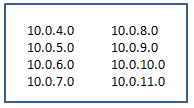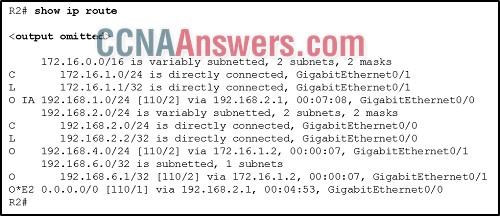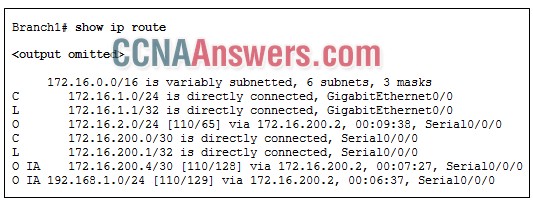CCNA 3 Chapter 9 V6.0 Answers
1. What are two reasons for creating an OSPF network with multiple areas? (Choose two.)
to provide areas in the network for routers that are not running OSPF
to ensure that an area is used to connect the network to the Internet
to reduce SPF calculations
to reduce use of memory and processor resources
to simplify configuration
2. Open the PT Activity. Perform the tasks in the activity instructions and then answer the question.
Fill in the blank. Do not use abbreviations.
What is the missing command on router R2 to establish an adjacency between routers R1 and R3?
Network 172.16.10.0 0.0.0.255 area 0
3. What OSPF LSA type is used to inform routers of the router ID of the DR in each multiaccess network in an OSPF area?
type 1
type 4
type 2
type 3
4. Refer to the exhibit. A network administrator has been asked to summarize the networks shown in the exhibit as part of a multiarea OSPF implementation. All addresses are using a subnet mask of 255.255.255.0. What is the correct summarization for these eight networks?

10.0.4.0 255.255.248.0
10.0.4.0 255.255.0.0
10.0.0.0 255.255.240.0
10.0.8.0 255.255.248.0
5. A network administrator is verifying a multi-area OSPF configuration by checking the routing table on a router in area 1. The administrator notices a route to a network that is connected to a router in area 2. Which code appears in front of this route in the routing table within area 1?
O IA
O E2
C
O
6. Fill in the blank. Use a number.
A type 4 LSA identifies the ASBR and provides a route to it.
7. Refer to the exhibit. What is indicated by the O IA in the router output?

The route was manually configured.
The route was learned from another area.
The route was learned from outside the internetwork.
The route was learned from within the area.
8. Match each type of OSPF router to its description. (Not all options are used.)

a router in the backbone area => backbone router
a router with all its interfaces in the same area => internal router
a router that has at least one interface that is attached to a non-OSPF network => Autonomous System Boundary Router
a router with its interfaces attached to multiple areas => Area Border Router
9. Which two statements correctly describe OSPF type 3 LSAs? (Choose two.)
Type 3 LSAs are used to update routes between OSPF areas.
Type 3 LSAs are known as autonomous system external LSA entries.
Type 3 LSAs are generated without requiring a full SPF calculation.
Type 3 LSAs are used for routes to networks outside the OSPF autonomous system.
Type 3 LSAs are known as router link entries.
10. Fill in the blank. Use a number.
An ASBR generates type 5 LSAs for each of its external routes and floods them into the area that it is connected to.
11. What is used to facilitate hierarchical routing in OSPF?
Autosummarization
frequent SPF calculations
the election of designated routers
the use of multiple areas
12. What type of OSPF LSA is originated by ASBR routers to advertise external routes?
type 5
type 3
type 2
type 1
13. Which characteristic describes both ABRs and ASBRs that are implemented in a multiarea OSPF network?
They both run multiple routing protocols simultaneously.
They usually have many local networks attached.
They are required to reload frequently and quickly in order to update the LSDB.
They are required to perform any summarization or redistribution tasks.
14. What routing table descriptor is used to identify OSPF summary networks that originate from an ABR?
O E1
O
O E2
O IA
15. Which three steps in the design and implementation of a multiarea OSPF network are considered planning steps? (Choose three.)
Troubleshoot the configurations.
Define the OSPF parameters.
Define the network requirements.
Verify OSPF.
Configure OSPF.
Gather the required parameters.
16. Open the PT Activity. Perform the tasks in the activity instructions and then answer the question.
Why are users in the OSPF network not able to access the Internet?
The network statement is misconfigured on router R1.
The OSPF timers that are configured on routers R1, R2, and R3 are not compatible.
The interface that is connected to the ISP router is down.
The default route is not redistributed correctly from router R1 by OSPF.
The OSPF network statements are misconfigured on routers R2 and R3.
17. Which two networks are part of the summary route 192.168.32.0/22? (Choose two.)
192.168.35.0/24
192.168.36.0/24
192.168.37.0/24
192.168.38.0/24
192.168.31.0/24
192.168.33.0/24
18. Fill in the blank. Do not use acronyms. OSPF type 2 LSA messages are only generated by the _designated_ router to advertise routes in multiaccess networks.
19. Refer to the exhibit. What can be concluded about network 192.168.4.0 in the R2 routing table?

This network should be used to forward traffic toward external networks.
The network was learned through summary LSAs from an ABR.
The network can be reached through the GigabitEthernet0/0 interface.
The network was learned from a router within the same area as R2.
20. The network administrator has been asked to summarize the routes for a new OSPF area. The networks to be summarized are 172.16.8.0, 172.16.10.0, and 172.16.12.0 with subnet masks of 255.255.255.0 for each network. Which command should the administrator use to forward the summary route for area 15 into area 0?
area 15 range 172.16.8.0 255.255.255.248
area 0 range 172.16.8.0 255.255.248.0
area 15 range 172.16.8.0 255.255.248.0
area 0 range 172.16.8.0 255.255.255.248
21. Refer to the exhibit. Fill in the blank. Do not use abbreviations.

The network 192.168.10.128 0.0.0.127 area 1 command must be issued to configure R1 for multiarea OSPF.
22. Refer to the exhibit. Which two statements are correct? (Choose two.)

The routing table contains routes from multiple areas.
The routing table contains two intra-area routes.
To reach network 172.16.2.0, traffic will travel through the GigabitEthernet0/0 interface.
The entry for 172.16.200.1 represents a loopback interface.
To reach network 192.168.1.0, traffic will exit via the Serial0/0/0 interface.


Leave a Reply